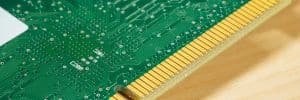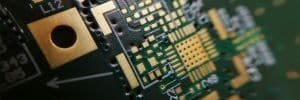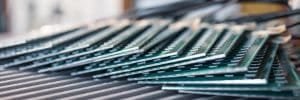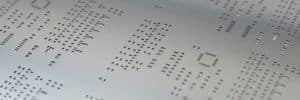With the popularization of electronic products and the expansion of market scale, as a core component of electronic products, printed circuit boards are being used more frequently. According to different end products and usage scenarios, as well as PCB production process limitations, the design of PCB circuit boards should also follow certain rules.

Below are several Guideline Rules to follow and keep in mind when designing PCBs. These general rules apply to most PCB manufacturers, but it is advisable to check with your fabricator.
Board Size
PCB manufacturers have a maximum size board they can handle. Typically this is also their panel size. The PCB fabrication house’s panel size is also important when mass-producing boards. In this situation, one would want to fit as many boards as possible on a panel with as little wasted board space (to reduce costs). Normal board spacing for routing (how boards are separated on a panel) is 0.3″, plus there is typically a 1.0″ to 2.0″ border on the board for handling it during processing.
Board thickness may also be specified. A standard thickness and type of board is .062″ FR4. Other typical board thickness are .010″, .020″, .031″, and .092″.
Trace Width and Spacing
The chemical and photographic processes used to produce a PCB put requirements on the minimum width of trace and the minimum spacing between traces. If a trace is made smaller than this minimum width, there is some chance it will open (no connection) when manufactured. If two traces are closer together than the minimum spacing, there is some chance they will be short when manufactured. These parameters are usually specified as “x/y rules,” where x is the minimum trace width, and y is the minimum trace spacing. For example, “8/10 rules” would indicate 8 mil minimum trace width and 10 mil minimum trace spacing. These rules (especially spacing) apply to any metal on the PCB, including a pad to track spacing and line widths for strings on the PCB.
Typical modern process rules are 8/8 rules with values as small as 2/2 rules being available. For Press-n-Peel, people have had success using 12/12 rules, but values a little larger are easier to make work consistently. However, keep in mind that the board must be soldered, and a trace within 8 mils (8/8 rules) of a pad is easier to short than one with greater spacing when hand soldered. For hand soldering, 10/10 rules are much easier to solder (if the design density can spice this large).
Pad Sizes
The biggest issues with pad size are solderability and manufacturability. Solderability is really just a matter of skill and will not be discussed here. Manufacturability is concerned with whether the pad will be broken when the hold is drilled in it. This is mainly a function of the accuracy of the PCB manufacturer’s drilling. If a drill hole is slightly off-center, the pad may be broken at one edge, possibly leading to an open circuit. A standard requirement for pad sizes is a 5 mil annulus. This means there must be .005″ all around the hole (i.e., a 28 mil hole would require a 38 mil pad). Something a little larger than this (maybe 10 mils) is recommended for solderability. AP Circuits states they have had relatively consistent success with a 2.5 mil annulus (i.e., a 20 mil hole with only a 25 mil pad), but they don’t recommend it.
Hole Sizes
Most PCB manufacturers have a wide selection of drill (hole) sizes available. Some charge per drill size used; others offer a standard set of drill sizes for no charge and then charge for non-standard drill sizes. AP Circuits uses the latter approach. When choosing a hole size, remember that the plate-through will cause the hole to be more narrow effectively. The plate-through thickness varies from .001″ to .003″. AP Circuits’ plate-through thickness is approximately .015″ (meaning the “finished hole” diameter is 3 mils smaller).
Standard Drill Sizes
Drill Number | Hole Size | Finished Hole Size |
70 | .028″ | .025″ |
65 | .035″ | .032″ |
58 | .042″ | .039″ |
55 | .052″ | .049″ |
53 | .0595″ | .056″ |
44 | .086″ | .083″ |
1/8″ | .125″ | .122″ |
24 | .152″ | .149″ |
Hole Density
Hole density is purely a cost issue. The more holes there are on a board, the more wear and tear manufacturing will put on the equipment (and the more the board will cost). Most PCB manufacturers have a maximum hole density, and boards with greater density are charged more. For AP Circuits, there is a per-hole charge for densities above 24 holes per square inch.
Drill Chart
Drill No. | Inches | Drill No. | Inches | Drill No. | Inches | ||
80 | .0135 | 53 | .0595 | 27 | .1440 | ||
79 | .0145 | 52 | .0635 | 26 | .1470 | ||
78 | .0160 | 51 | .0670 | 25 | .1495 | ||
77 | .0180 | 50 | .0700 | 24 | .1520 | ||
76 | 0200 | 49 | .0730 | 23 | .1540 | ||
75 | .0210 | 48 | .0760 | 22 | .1570 | ||
74 | .0225 | 47 | .0785 | 21 | .1590 | ||
73 | .0240 | 46 | .0810 | 20 | .1610 | ||
72 | .0250 | 45 | .0820 | 19 | .1660 | ||
71 | .0260 | 44 | .0860 | 18 | .1695 | ||
70 | .0280 | 43 | .0890 | 17 | .1730 | ||
69 | .0292 | 42 | .0935 | 16 | .1770 | ||
68 | .0310 | 41 | .0960 | 15 | .1800 | ||
67 | .0320 | 40 | .0980 | 14 | .1820 | ||
66 | .0330 | 39 | .0995 | 13 | .1850 | ||
65 | .0350 | 38 | .1015 | 12 | .1890 | ||
64 | .0360 | 37 | .1040 | 11 | .1910 | ||
63 | .0370 | 36 | .1065 | 10 | .1935 | ||
62 | .0380 | 35 | .1100 | 09 | .1960 | ||
61 | .0390 | 34 | .1110 | 08 | .1990 | ||
60 | .0400 | 33 | .1130 | 07 | .2010 | ||
59 | .0410 | 32 | .1160 | 06 | .2040 | ||
58 | .0420 | 31 | .1200 | 05 | .2055 | ||
57 | .0430 | 1/8″ | .1250 | 04 | .2090 | ||
56 | .0465 | 30 | .1285 | 03 | .2130 | ||
55 | .0520 | 29 | .1360 | 02 | .2210 | ||
54 | .0550 | 28 | .1405 | 01 | .2280 |
dBm – Volts – Watts Conversion
dBm | V | Po | dBm | V | Po | dBm | UV | Po | ||
+53 | 100.0 | 200W | +7 | 0.50 | 5mW | -37 | 3.2 | |||
+50 | 70.0 | 100W | +6 | 0.445 | 4mW | -38 | 2.85 | |||
+49 | 64.0 | 80W | +5 | 0.40 | 3.2mW | -39 | 2.5 | |||
+48 | 58.0 | 64W | +4 | 0.355 | 2.5mW | -40 | 2.25 | 0.1uW | ||
+47 | 50.0 | 50W | +3 | 0.320 | 2.0mW | -41 | 2.0 | |||
+46 | 44.5 | 40W | +2 | 0.280 | 1.6mW | -42 | 1.8 | |||
+45 | 40.0 | 32W | +1 | 0.252 | 1.25mW | -43 | 1.6 | |||
+44 | 32.5 | 25W | 0 | 0.225 | 1.00mW | -44 | 1.4 | |||
+43 | 32.0 | 20W | -1 | 0.200 | 0.80mW | -45 | 1.25 | |||
+42 | 28.0 | 16W | -2 | 0.180 | 0.64mW | -46 | 1.18 | |||
+41 | 26.2 | 12.5W | -3 | 0.160 | 0.50mW | -47 | 1.00 | |||
+40 | 22.5 | 10W | -4 | 0.141 | 0.40mW | -48 | 0.90 | |||
+39 | 20.0 | 8W | -5 | 0.125 | 0.32mW | -49 | 800 | |||
+38 | 18.0 | 6.4W | -6 | 0.115 | 0.25mW | -50 | 710 | 0.01uW | ||
+37 | 16.0 | 5W | -7 | 0.100 | 0.20mW | -51 | 640 | |||
+36 | 14.1 | 4W | -8 | 0.090 | 0.16mW | -52 | 570 | |||
+35 | 12.5 | 3.2W | -9 | 0.080 | 0.125mW | -53 | 500 | |||
+34 | 11.5 | 2.5W | -10 | 0.071 | 0.10mW | -54 | 450 | |||
+33 | 10.0 | 2W | -11 | 64 | -55 | 0.40 | ||||
+32 | 9.0 | 1.6W | -12 | 58 | -56 | 351 | ||||
+31 | 8.0 | 1.25W | -13 | 50 | -57 | 320 | ||||
+30 | 7.10 | 1.0W | -14 | 45 | -58 | 286 | ||||
+29 | 6.40 | 800mW | -15 | 40 | -59 | 251 | ||||
+28 | 5.80 | 640mW | -16 | 35.5 | -60 | 225 | 0.001uW | |||
+27 | 5.00 | 500mW | -17 | 31.5 | -61 | 200 | ||||
+26 | 4.45 | 400mW | -18 | 28.5 | -62 | 180 | ||||
+25 | 4.00 | 320mW | -19 | 25.1 | -63 | 160 | ||||
+24 | 3.55 | 250mW | -20 | 22.5 | 0.01mW | -64 | 141 | |||
+23 | 3.20 | 200mW | -21 | 20.0 | -65 | 128 | ||||
+22 | 2.80 | 160mW | -22 | 17.9 | -66 | 115 | ||||
+21 | 2.52 | 125mW | -23 | 15.9 | -67 | 100 | ||||
+20 | 2.25 | 100mW | -24 | 14.1 | -68 | 90 | ||||
+19 | 2.00 | 80mW | -25 | 12.8 | -69 | 80 | ||||
+18 | 1.80 | 64mW | -26 | 11.5 | -70 | 71 | 0.1nW | |||
+17 | 1.60 | 50mW | -27 | 10.0 | -71 | 65 | ||||
+16 | 1.41 | 40mW | -28 | 8.9 | -72 | 58 | ||||
+15 | 1.25 | 32mW | -29 | 8.0 | -73 | 50 | ||||
+14 | 1.15 | 25mW | -30 | 7.1 | 0.001mW | -74 | 45 | |||
+13 | 1.00 | 20mW | -31 | 6.25 | -75 | 40 | ||||
+12 | 0.90 | 16mW | -32 | 5.8 | -76 | 35 | ||||
+11 | 0.80 | 12.5mW | -33 | 5.0 | -77 | 32 | ||||
+10 | 0.71 | 10mW | -34 | 4.5 | -78 | 29 | ||||
+9 | 0.64 | 8mW | -35 | 4.0 | -79 | 25 | ||||
+8 | 0.58 | 6.4mW | -36 | 3.5 | -80 | 22.5 | 0.01nW |
Getek® Laminates – Epoxy / Polyphenylene Oxide Resin
(Type: NEMA FR-4, IPC-L-108B/04)
Nominal thickness | Thickness tolerance | GE grade | E-Glass construction | Dk@1MHz. |
0.0027″ | ±0.0005″ | ML200D | 1080 | 3.8 |
0.004″ | ±0.0005″ | ML200D | 2313 | 3.9 |
0.005″ | ±0.0007″ | ML200M | 2313/106 | 3.8 |
0.006″ | ±0.0007″ | ML200D | 2313/1080 | 3.9 |
0.007″ | ±0.0010″ | ML200M | (2)2313 | 3.8 |
0.008″ | ±0.0010″ | ML200D | 2313/2116 | 3.9 |
0.010″ | ±0.0010″ | ML200D | (2)2116 | 3.9 |
0.012″ | ±0.0010″ | ML200D | 1080/7628/1080 | 3.9 |
0.014″ | ±0.0015″ | ML200D | (2)7628 | 4.2 |
0.018″ | ±0.0015″ | ML200D | 7628/2313/7628 | 4.1 |
0.021″ | ±0.0020″ | ML200D | (3)7628 | 4.2 |
0.024″ | ±0.0020″ | ML200C | 2116/(2)7628/2116 | 4.1 |
0.028″ | ±0.0020″ | ML200D | (4)7628 | 4.2 |
0.028″(Alt.) | ±0.0020″ | ML200C | 1080/2313/(3)2116/2313/1080 | 3.8 |
0.031″ | ±0.0030″ | ML200C | 2116/(3)7628/2116 | 4.1 |
0.031″1 | ±0.0040″ | ML200D | (4)7628 | 4.2 |
0.044″1 | ±0.0050″ | ML200D | (6)7628 | 4.2 |
0.059″1 | ±0.0050″ | ML200D | (8)7628 | 4.2 |
VSWR Vs. Return Loss
VSWR | Ret. Loss | VSWR | Ret. Loss | VSWR | Ret. Loss | VSWR | Ret. Loss | VSWR | Ret. Loss |
1.01 | -46.064 | 1.51 | -13.842 | 1.79 | -10.960 | 2.18 | -8.611 | 2.57 | -7.135 |
1.02 | -40.086 | 1.52 | -13.708 | 1.80 | -10.881 | 2.19 | -8.565 | 2.58 | -7.105 |
1.03 | -36.608 | 1.53 | -13.577 | 1.81 | -10.804 | 2.20 | -8.519 | 2.59 | -7.074 |
1.04 | -34.151 | 1.54 | -13.449 | 1.82 | -10.729 | 2.21 | -8.474 | 2.60 | -7.044 |
1.05 | -32.256 | 1.55 | -13.324 | 1.83 | -10.654 | 2.22 | -8.430 | 2.61 | -7.014 |
1.06 | -30.714 | 1.56 | -13.201 | 1.84 | -10.581 | 2.23 | -8.386 | 2.62 | -6.984 |
1.07 | -29.417 | 1.57 | -13.081 | 1.85 | -10.509 | 2.24 | -8.342 | 2.63 | -6.954 |
1.08 | -28.299 | 1.58 | -12.964 | 1.86 | -10.437 | 2.25 | -8.299 | 2.64 | -6.925 |
1.09 | -27.318 | 1.59 | -12.849 | 1.87 | -10.367 | 2.26 | -8.257 | 2.65 | -6.896 |
1.10 | -26.444 | 1.60 | -12.736 | 1.88 | -10.298 | 2.27 | -8.215 | 2.66 | -6.867 |
1.11 | -25.658 | 1.61 | -12.626 | 1.89 | -10.230 | 2.28 | -8.173 | 2.67 | -6.839 |
1.12 | -24.943 | 1.62 | -12.518 | 1.90 | -10.163 | 2.29 | -8.132 | 2.68 | -6.811 |
1.13 | -24.289 | 1.63 | -12.412 | 1.91 | -10.097 | 2.30 | -8.091 | 2.69 | -6.783 |
1.14 | -23.686 | 1.64 | -12.308 | 1.92 | -10.032 | 2.31 | -8.051 | 2.70 | -6.755 |
1.15 | -23.127 | 1.65 | -12.207 | 1.93 | -9.968 | 2.32 | -8.011 | 2.71 | -6.728 |
1.16 | -22.607 | 1.66 | -12.107 | 1.94 | -9.904 | 2.33 | -7.972 | 2.72 | -6.700 |
1.17 | -22.120 | 1.67 | -12.009 | 1.95 | -9.842 | 2.34 | -7.933 | 2.73 | -6.673 |
1.18 | -21.664 | 1.68 | -11.913 | 1.96 | -9.780 | 2.35 | -7.894 | 2.74 | -6.646 |
1.19 | -21.234 | 1.69 | -11.818 | 1.97 | -9.720 | 2.36 | -7.856 | 2.75 | -6.620 |
1.20 | -20.828 | 1.70 | -11.725 | 1.98 | -9.660 | 2.37 | -7.818 | 2.76 | -6.594 |
1.21 | -20.443 | 1.71 | -11.634 | 1.99 | -9.601 | 2.38 | -7.781 | 2.77 | -6.567 |
1.22 | -20.079 | 1.72 | -11.545 | 2.00 | -9.542 | 2.39 | -7.744 | 2.78 | -6.541 |
1.23 | -19.732 | 1.73 | -11.457 | 2.01 | -9.485 | 2.40 | -7.707 | 2.79 | -6.516 |
1.24 | -19.401 | 1.74 | -11.370 | 2.02 | -9.428 | 2.41 | -7.671 | 2.80 | -6.490 |
1.25 | -19.085 | 1.75 | -11.285 | 2.03 | -9.372 | 2.42 | -7.635 | 2.81 | -6.465 |
1.26 | -18.783 | 1.76 | -11.202 | 2.04 | -9.317 | 2.43 | -7.599 | 2.82 | -6.440 |
1.27 | -18.493 | 1.77 | -11.120 | 2.05 | -9.262 | 2.44 | -7.564 | 2.83 | -6.415 |
1.28 | -18.216 | 1.78 | -11.039 | 2.06 | -9.208 | 2.45 | -7.529 | 2.84 | -6.390 |
1.29 | -17.949 | 1.40 | -15.563 | 2.07 | -9.155 | 2.46 | -7.494 | 2.85 | -6.366 |
1.30 | -17.692 | 1.41 | -15.385 | 2.08 | -9.103 | 2.47 | -7.460 | 2.86 | -6.341 |
1.31 | -17.445 | 1.42 | -15.211 | 2.09 | -9.051 | 2.48 | -7.426 | 2.87 | -6.317 |
1.32 | -17.207 | 1.43 | -15.043 | 2.10 | -8.999 | 2.49 | -7.393 | 2.88 | -6.293 |
1.33 | -16.977 | 1.44 | -14.879 | 2.11 | -8.949 | 2.50 | -7.360 | 2.89 | -6.270 |
1.34 | -16.755 | 1.45 | -14.719 | 2.12 | -8.899 | 2.51 | -7.327 | 2.90 | -6.246 |
1.35 | -16.540 | 1.46 | -14.564 | 2.13 | -8.849 | 2.52 | -7.294 | 2.91 | -6.223 |
1.36 | -16.332 | 1.47 | -14.412 | 2.14 | -8.800 | 2.53 | -7.262 | 2.92 | -6.200 |
1.37 | -16.131 | 1.48 | -14.264 | 2.15 | -8.752 | 2.54 | -7.230 | 2.93 | -6.177 |
1.38 | -15.936 | 1.49 | -14.120 | 2.16 | -8.705 | 2.55 | -7.198 | 2.94 | -6.154 |
1.39 | -15.747 | 1.50 | -13.979 | 2.17 | -8.657 | 2.56 | -7.167 | 2.95 | -6.131 |
VSWR Vs. Return Loss (Continued)
VSWR | Ret. Loss | VSWR | Ret. Loss | VSWR | Ret. Loss | VSWR | Ret. Loss | VSWR | Ret. Loss |
2.96 | -6.109 | 3.07 | -5.872 | 3.18 | -5.654 | 3.29 | -5.452 | 3.40 | -5.265 |
2.97 | -6.086 | 3.08 | -5.852 | 3.19 | -5.635 | 3.30 | -5.435 | 3.41 | -5.248 |
2.98 | -6.064 | 3.09 | -5.832 | 3.20 | -5.617 | 3.31 | -5.417 | 3.42 | -5.232 |
2.99 | -6.042 | 3.10 | -5.811 | 3.21 | -5.598 | 3.32 | -5.400 | 3.43 | -5.216 |
3.00 | -6.021 | 3.11 | -5.791 | 3.22 | -5.579 | 3.33 | -5.383 | 3.44 | -5.200 |
3.01 | -5.999 | 3.12 | -5.771 | 3.23 | -5.561 | 3.34 | -5.365 | 3.45 | -5.184 |
3.02 | -5.977 | 3.13 | -5.751 | 3.24 | -5.542 | 3.35 | -5.348 | 3.46 | -5.168 |
3.03 | -5.956 | 3.14 | -5.732 | 3.25 | -5.524 | 3.36 | -5.331 | 3.47 | -5.152 |
3.04 | -5.935 | 3.15 | -5.712 | 3.26 | -5.506 | 3.37 | -5.315 | 3.48 | -5.137 |
3.05 | -5.914 | 3.16 | -5.693 | 3.27 | -5.488 | 3.38 | -5.298 | 3.49 | -5.121 |
3.06 | -5.893 | 3.17 | -5.674 | 3.28 | -5.470 | 3.39 | -5.281 | 3.50 | -5.105 |
WIRE DATA CHART
AWG | Diam | AWG | Diam | AWG | Diam | AWG | Diam | |||
4/0 | 0.4600 | 9 | 0.1144 | 21 | 0.0285 | 33 | 0.0071 | |||
3/0 | 0.4096 | 10 | 0.1019 | 22 | 0.0253 | 34 | 0.0063 | |||
2/0 | 0.3648 | 11 | 0.0907 | 23 | 0.0226 | 35 | 0.0056 | |||
1/0 | 0.3249 | 12 | 0.0808 | 24 | 0.0201 | 36 | 0.0050 | |||
1 | 0.2893 | 13 | 0.0720 | 25 | 0.0179 | 37 | 0.0045 | |||
2 | 0.2576 | 14 | 0.0641 | 26 | 0.0159 | 38 | 0.0040 | |||
3 | 0.2294 | 15 | 0.0571 | 27 | 0.0142 | 39 | 0.0035 | |||
4 | 0.2043 | 16 | 0.0508 | 28 | 0.0126 | 40 | 0.0031 | |||
5 | 0.1819 | 17 | 0.0453 | 29 | 0.0113 | 41 | 0.0028 | |||
6 | 0.1620 | 18 | 0.0403 | 30 | 0.0100 | 42 | 0.0025 | |||
7 | 0.1443 | 19 | 0.0359 | 31 | 0.0089 | 43 | 0.0022 | |||
8 | 0.1285 | 20 | 0.0320 | 32 | 0.0080 | 44 | 0.0020 |
PCMCIA CONNECTOR PINOUT
16-Bit Pin | 32-bit Memory | 16-Bit I/O+Mem | 32-bit CardBus | Pin | Memory | I/O+Mem | CardBus |
1 | GND | GND | GND | 35 | GND | GND | GND |
2 | D3 | D3 | CAD0 | 36 | CD1# | CD1# | CCD1# |
3 | D4 | D4 | CAD1 | 37 | D11 | D11 | CAD2 |
4 | D5 | D5 | CAD3 | 38 | D12 | D12 | CAD4 |
5 | D6 | D6 | CAD5 | 39 | D13 | D13 | CAD6 |
6 | D7 | D7 | CAD7 | 40 | D14 | D14 | RSRVD |
7 | CE1# | CE1# | CCBE0# | 41 | D15 | D15 | CAD8 |
8 | A10 | A10 | CAD9 | 42 | CE2# | CE2# | CAD10 |
9 | OE# | OE# | CAD11 | 43 | VS1# | VS1# | CVS1 |
10 | A11 | A11 | CAD12 | 44 | RSRVD | IORD# | CAD13 |
11 | A9 | A9 | CAD14 | 45 | RSRVD | IOWR# | CAD15 |
12 | A8 | A8 | CCBE1# | 46 | A17 | A17 | CAD16 |
13 | A13 | A13 | CPAR | 47 | A18 | A18 | RSRVD |
14 | A14 | A14 | CPERR# | 48 | A19 | A19 | CBLOCK# |
15 | WE# | WE# | CGNT# | 49 | A20 | A20 | CSTOP# |
16 | READY | IREQ# | CINT# | 50 | A21 | A21 | CDEVSEL# |
17 | Vcc | Vcc | Vcc | 51 | Vcc | Vcc | Vcc |
18 | Vpp1 | Vpp1 | Vpp1 | 52 | Vpp2 | Vpp2 | Vpp2 |
19 | A16 | A16 | CCLK | 53 | A22 | A22 | CTRDY# |
20 | A15 | A15 | CIRDY# | 54 | A23 | A23 | CFRAME# |
21 | A12 | A12 | CCBE2# | 55 | A24 | A24 | CAD17 |
22 | A7 | A7 | CAD18 | 56 | A25 | A25 | CAD19 |
23 | A6 | A6 | CAD20 | 57 | VS2# | VS2# | CVS2 |
24 | A5 | A5 | CAD21 | 58 | RESET | RESET | CRST# |
25 | A4 | A4 | CAD22 | 59 | WAIT# | WAIT# | CSERR# |
26 | A3 | A3 | CAD23 | 60 | RSRVD | INPACK# | CREQ# |
27 | A2 | A2 | CAD24 | 61 | REG# | REG# | CCBE3# |
28 | A1 | A1 | CAD25 | 62 | BVD2 | SPKR# | CAUDIO |
29 | A0 | A0 | CAD26 | 63 | BVD1 | STSCHG# | CSTSCHG |
30 | D0 | D0 | CAD27 | 64 | D8 | D8 | CAD28 |
31 | D1 | D1 | CAD29 | 65 | D9 | D9 | CAD30 |
32 | D2 | D2 | RSRVD | 66 | D10 | D10 | CAD31 |
33 | WP | IOIS16# | CCLKRUN# | 67 | CD2# | CD2# | CCD2# |
34 | GND | GND | GND | 68 | GND | GND | GND |
TRACE SPACING GUIDELINE
Voltage Between Conductors
VDC or Peak | A1 | A2 | A3 | A4 | A5 | A6 | A7 |
0 thru | .004 | 0.025 | 0.025 | 0.005 | 0.005 | 0.005 | 0.005 |
16 thru | .004 0 | .025 | 0.025 | 0.005 | 0.005 | 0.010 | 0.005 |
31 thru | .004 | 0.025 | 0.025 | 0.005 | 0.005 | 0.015 | 0.005 |
51 thru 100 | 0.004 | 0.025 | 0.060 | 0.005 | 0.005 | 0.020 | 0.005 |
101 thru 150 | 0.008 | 0.025 | 0.125 | 0.015 | 0.015 | 0.030 | 0.015 |
151 thru 170 | 0.008 | 0.050 | 0.125 | 0.015 | 0.015 | 0.030 | 0.015 |
171 thru 250 | 0.008 | 0.050 | 0.250 | 0.015 | 0.015 | 0.030 | 0.015 |
251 thru 300 | 0.008 | 0.050 | 0.500 | 0.015 | 0.015 | 0.030 | 0.015 |
301 thru 500 | 0.010 | 0.100 | 0.500 | 0.030 | 0.030 | 0.060 | 0.030 |
More than 500 | 0.0001/V | 0.0002/V 0.001/V | 0.00012/V | 0.00012/V | 0.00012/V | 0.00012/V |
A1 – Internal Conductors
A2 – External Conductors, uncoated, sea level to 10,000 ft.
A3 – External Conductors, uncoated, over 10,000 ft.
A4 – External Conductors, with permanent polymer coating (Solder Mask).
A5 – External Conductors, with a conformal coating over the assembly.
A6 – External Component lead/termination, uncoated.
A7 – External Component lead/termination, with conformal coating.
Electrical Design Factors
Conductor Capacitance
C = 0.31 a/b + 0.23(1 + k) log10 (1 + 2b/d +2b + b2/d2)
Where
k = Substrate dielectric constant
a = Conductor thickness
b = Width of conductor in inches
d = Distance between conductors in inches
Conductor Resistance
R = 0.000227W
Where
W = Width of conductor
Characteristic Impedance
Zo = R + jwL / G + kwC
Where
Zo = Apparent Z of an infinitely long line in ohms
R = Resistance in ohms
L = Inductance in Henries
G = Conductor per unit length of line in mhos
C = Capacitance in farads
Characteristic Impedance for a Micro Strip
Zo = (h/W) (377 / (Sqrt. er) {1 + (2h/PI W)[1 + ln(PI W/h)]}
Where
h = Dielectric thickness
W = Micro Strip width
er = Effective dielectric constant of substrate
Related Posts
- HDI PCB Layout and Basic HDI Design Guidelines
- Basic Knowledge of PCB Pad Design
- 10 Tips To Improve PCB Design For Manufacturability
- PCB Terminology Glossary
- PCB Design Software Free Download
- Five factors that FPC PCB designers should know about impedance control
- What are the aspects of PCB Design For Manufacturing (DFM) and Design For Assembly (DFA)?
- A Free Software for PCB Design for Manufacturing or DFM Analysis






















